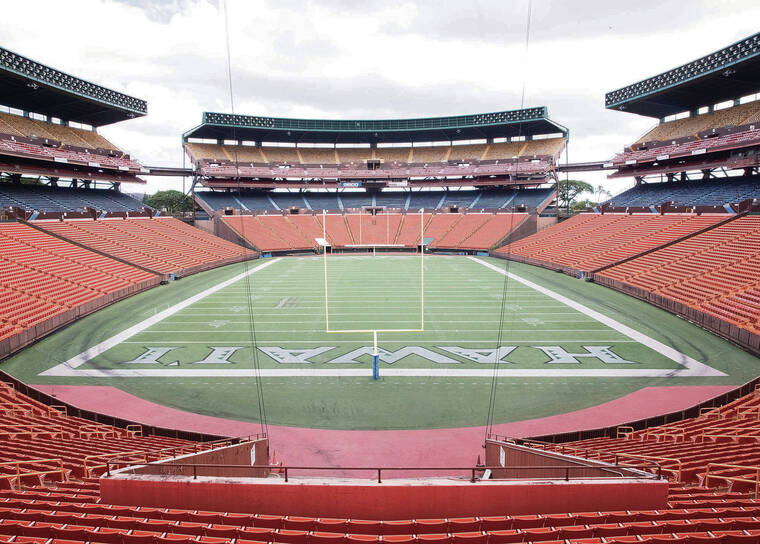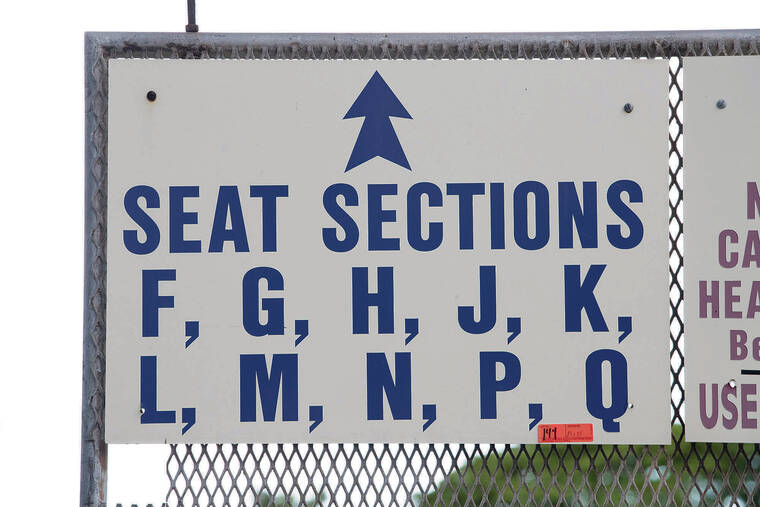Hundreds of Aloha Stadium artifacts sold at auction

CINDY ELLEN RUSSELL / CRUSSELL@STARADVERTISER.COM
Pictured is an overall of the stadium.

CINDY ELLEN RUSSELL / CRUSSELL@STARADVERTISER.COM
The state has auctioned off hundreds of parts, signs, pieces of equipment and memorabilia from Aloha Stadium.


A state agency unloaded over 500 items from Aloha Stadium including seat backs and pieces of artificial turf at an auction that ended Wednesday evening ahead of a still-uncertain plan to replace the 47-year-old facility in Halawa.
Final bidding at the online event kicked off with a handful of items including Lot 1, a metal “Welcome to Aloha Stadium” sign outside the facility’s main entry, which sold for $1,125.
About three hours later the event concluded with the sale of Lot 245, where the attraction appeared to be a CD of baseball game organ music that got bid up to $105 from $74 over about 20 minutes of extended bidding time.
“The response was great,” said Dave Brandt, vice president at Oahu Auctions, which conducted the sale for the Stadium Authority. In all, 534 of 551 items or groups of items posted for sale were sold.
Proceeds will go to the Stadium Authority’s general fund, though the agency declined to disclose total revenue raised from what represents the first of several planned sales from Hawaii’s largest entertainment venue.
The initial auction had a heavy concentration of memorabilia but also more utilitarian things such as directional signs and equipment. The highest-priced sale was a golf cart that went for $5,050. Other pricey items included a carbon fiber video tripod that sold for $2,275 and a Fujinon broadcast TV camera lens that sold for $1,050.
Don't miss out on what's happening!
Stay in touch with breaking news, as it happens, conveniently in your email inbox. It's FREE!
Half-square-foot remnant pieces of artificial field turf sold at various prices including $16 and $18. The authority aims to find a single buyer for the 110,000 square feet of turf currently on the gridiron, which was installed in 2016 at a cost of $1.2 million.
About 200 seat backs in the 50,000-seat stadium were in the initial auction with a $10 minimum bid requirement, though not all of them sold. Some are from the stadium’s topmost “yellow” tier, which had been weather- beaten to a gray hue.
“It’s amazing what the sun can do,” Brandt said. “The color of these seats was no match for the Hawaiian sun.”
Still, there was interest for some of the “badly faded” seat backs, including the one connected to Seat 3 in the seventh row of the R section, which got bid up to $31 from $12.
Items expected to be featured in upcoming auctions include goal posts, about 2,000 program booklets from the last Pro Bowl played at Aloha Stadium in 2016, player equipment lockers, pay phones, heavy equipment, as well as more signs, golf carts and memorabilia.
Brandt said the next event will likely be for University of Hawaii football season-ticket holders who will be given the opportunity to buy the entire seat they typically sat in for a fixed price.
The Stadium Authority, which manages the property, closed the facility for spectator use in December 2020 because of maintenance expense needs and little revenue amid coronavirus restrictions.
The surprise move prompted UH, which had played home games at the stadium since it opened in 1975, to hurriedly add seating and other features to its main football practice field in Manoa in 2021 at a cost of $8 million. UH plans to spend $20 million more to further expand its on-campus facility before 2023’s football season starts for continued interim use until a new stadium in Halawa is built.
More than a decade ago, state leaders agreed that it would be more cost-effective in the long term to replace the “Rust Palace” rather than keep up with exceedingly expensive maintenance.
A new, roughly 35,000-seat stadium was initially projected to open in 2023 on part of the state-owned 98-acre stadium site before the existing facility would be demolished, but shifting approaches by state lawmakers, the state Department of Accounting and General Services and, most recently, Gov. David Ige have hindered the project.
The plan once endorsed by Ige called for the state contributing up to $350 million to a new stadium designed, built and maintained by a private developer while the state operated the facility and generated income to pay off the taxpayer expense by leasing surrounding state land to a developer producing a new residential and commercial community.
DAGS was heading up the procurement for the Stadium Authority and has spent about $25 million on work to date, but Ige declared in September that another agency — the Department of Business, Economic Development and Tourism — would instead produce a new stadium under a low-bid contract process.
Ige’s term ends in December, so the future of the stadium likely will be up to the next governor and lawmakers.



